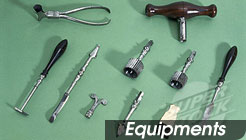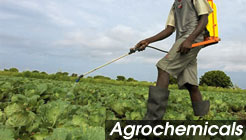Products
Trypanocidal agent is an antiprotozoal agent that acts upon on trypanosome parasites.
Antibacterial is a compound or substance that kills or slows down the growth of bacteria. The term is often used synonymously with the term Antibiotic(s); today, however, with increased knowledge of the causative agents of various infectious diseases, antibiotic(s) has come to denote a broader range of antimicrobial compounds, including anti-fungal and other compounds.
Anthelmintics or antihelminthics are drugs that expel parasitic worms (helminths) from the body, by either stunning or killing them. They may also be called vermifuges (stunning) or vermicides (killing).
Acaricides are pesticides that kill members of the Acari group, which includes ticks and mites. Acaricides are used both in medicine and agriculture, although the desired selective toxicity differs between the two fields.
Biologicals Biological products used to induce immunity to various infectious diseases or noxious substances of biological origin.
Herbicides, commonly known as a weed killer, is a type of pesticide used to kill unwanted plants. Selective herbicides kill specific targets while leaving the desired crop relatively unharmed.
Fungicides are chemical compounds or biological organisms used to kill or inhibit fungi or fungal spores.
Insecticides are pesticides used against insects. They include ovicides and larvicides used against the eggs and larvae of insects respectively.
Microscopes are instruments used to see objects that are too small for the naked eye.
Centrifuges are pieces of equipments, generally driven by an electric motor (some older models were spun by hand), that puts an object in rotation around a fixed axis, applying a force perpendicular to the axis
Syringes are simple piston pumps consisting of a plunger that fits tightly in a tube. The plunger can be pulled and pushed along inside a cylindrical tube (the barrel), allowing the syringe to take in and expel a liquid or gas through an orifice at the open end of the tube. The open end of the syringe may be fitted with a hypodermic needle, a nozzle, or tubing to help direct the flow into and out of the barrel.
Scalpel, or lancet, is a small, thin and extremely sharp bladed instrument used for surgery, anatomical dissection, and various arts and crafts (called a hobby knife). Scalpels may be single-use disposable or re-usable. Re-usable scalpels can have attached, resharpenable blades or, more commonly, non-attached, replaceable blades.
Scalpel blades are usually made of hardened and tempered steel, stainless steel, or high carbon steel; in addition, titanium, ceramic, diamond and even obsidian knives are not uncommon.
Medical Glove is a disposable garment covering the hand used during medical examinations and procedures to help prevent contamination between caregivers and caretakers.
Knapsack sprayer is a piece of equipment that spray nozzles to apply herbicides, pesticides, and fertilizers to agricultural crops.



